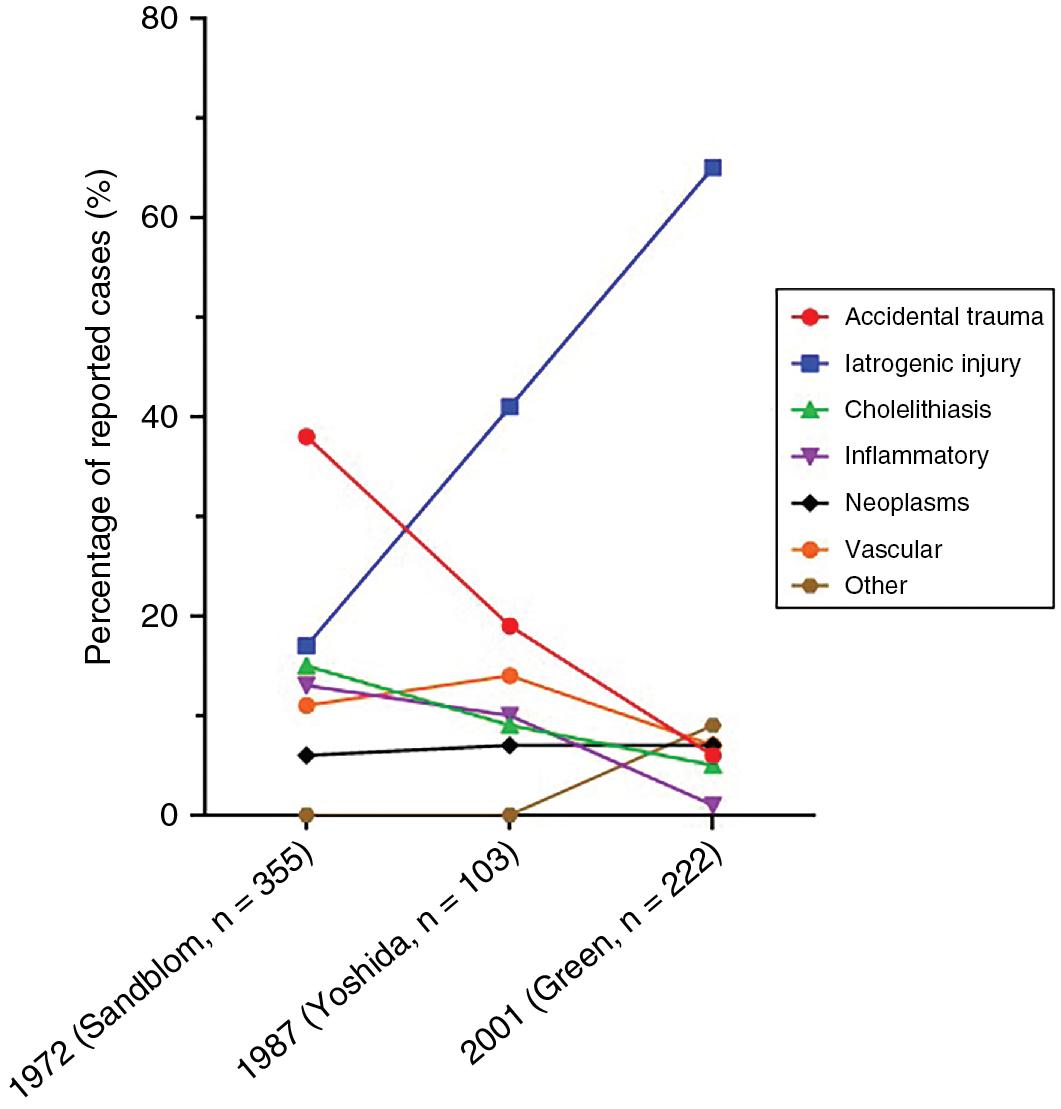Physical Address
304 North Cardinal St.
Dorchester Center, MA 02124
Hemobilia and bilhemia are clinical phenomena that arise from admixing of blood and bile due to anomalous connection between the bloodstream and biliary tract. In general terms, a fistula between the hepatic arterial supply and the bile ducts can lead to blood invading the biliary tree, leading to hemobilia. Similarly, aberrant connection between the biliary tract and the portal or hepatic venous supply can result in hemobilia, or in bile entering the bloodstream and systemic circulation leading to bilhemia. This reverse flow of bile into the circulatory system is facilitated by high biliary ductal pressures, such as in the case of obstructive jaundice, and the low-pressure venous system. Although rare, these conditions can be clinically significant and lead to major morbidity and mortality if not identified and rectified appropriately. , The epidemiologic and therapeutic landscape for hemobilia/bilhemia has shifted over time, but awareness of the pathophysiology, etiology, and clinical manifestations is key to early diagnosis and effective management of these disorders. , ,
The pathophysiology of hemobilia/bilhemia pertains directly to the dual blood supply of the liver and the intimate relationship between bile ducts and blood vessels within the hepatic parenchyma (see Chapters 2 and 5 ). Briefly, the liver receives 25% of its total blood flow (and 30%–50% of its oxygen content) from the hepatic artery, with the portal venous system accounting for the remainder. Importantly, the hepatic arterial system is the sole source of blood supply to the intrahepatic bile ducts. The hepatic arterioles, portal venules, and bile ductules exist in close proximity within the hepatic parenchyma. In the context of hemobilia, any aberrant fistulous connection between either the arterial and biliary system (and to a lesser extent portal/venous and biliary system) can lead to blood leaving the high-pressure arterial system and translocating along a pressure gradient to enter the lower pressure biliary system. The bleeding can arise from anywhere along the intrahepatic and extrahepatic biliary tract, or the liver parenchyma itself. Blood then courses through the biliary ductal system to enter the gastrointestinal tract. As such, significant hemobilia will classically manifest as upper gastrointestinal bleeding. In the context of indwelling biliary drains, the bleeding may also manifest as blood per the drainage system itself. Additionally, the hemorrhage may lead to formation of blood clots in the biliary tract (given the propensity of blood to precipitate away from bile due to difference in composition and viscosity), thereby leading to biliary obstruction (see Chapter 8 ). This in turn can manifest as right upper quadrant pain and jaundice. Indeed, this trifecta of signs and symptoms—upper gastrointestinal hemorrhage, jaundice, and right upper quadrant abdominal pain—are collectively designated as Quincke’s triad of hemobilia, originally described in 1871. Gastrointestinal bleeding can either be melena or frank hematemesis in 90% or 60% of cases, respectively, and pain is seen in 70% of cases and jaundice in 60%. Though all three findings may comanifest in only 22% to 35% of patients with hemobilia, any combination of gastrointestinal bleeding with jaundice or right abdominal pain, especially in the context of a history of hepatic trauma or instrumentation, should raise suspicion for hemobilia. In addition to pain and jaundice, the blood clots, if left unaddressed, can also lead to choledocholithiasis (see Chapter 33 ), cholangitis (see Chapter 43 ), cholecystitis (see Chapter 34 ), and pancreatitis (see Chapter 54, Chapter 55, Chapter 56, Chapter 57, Chapter 58 ), depending on where they come to rest within the biliary tree. , Laboratory abnormalities associated with hemobilia include findings of anemia and elevated liver enzymes (particularly bilirubin and alkaline phosphatase) based on the severity and chronicity of the disease. For reference, the average laboratory values for a series of 37 patients with hemobilia included hemoglobin of 10.6 g/dL (range 7.3–15.8 g/dL), aspartate aminotransferase (AST) of 353 IU/L, alanine aminotransferase (ALT) of 243 IU/L, alkaline phosphatase of 834 IU/L, γ-glutamyl transferase (GGT) of 385 IU/L, and total bilirubin of 10.5 mg/dL.
Bilhemia, on the other hand, arises from the reverse flow of bile into the systemic circulation, typically through abnormal conduits into the portal or hepatic venous systems. , As mentioned previously, this problem is exacerbated by concomitant biliary obstruction (see Chapter 8 ), which can increase the pressure within the biliary system over that of the venous system. The symptoms of bilhemia typically manifest as rising serum bilirubin levels without a corresponding rise in liver function tests. Thus, much like in obstructive biliary diseases, bilhemia can result in jaundice. The more feared consequence of bilhemia is septicemia secondary to flow of infected bile into the sterile bloodstream. Bilhemia should therefore be part of the differential diagnosis alongside more common disorders, such as cholangitis (see Chapter 43 ), in septic patients with rising direct serum bilirubin levels.
Advances in the management of hepatobiliary trauma (see Chapters 113 ) and minimally invasive hepatobiliary procedures (see Chapter 127 ) have led to a shift in the common etiologies of hemobilia and bilhemia ( Fig. 116.1 ). , , Accidental hepatic trauma was historically the most common cause, but most instances of hemobilia/bilhemia are now iatrogenic secondary to percutaneous or endoscopic diagnostic and therapeutic interventions (see Chapters 23 , 30 , 31 , 52 , 85 , and 96 ), malignancies (see Chapters 50 , 89 , and Chapter 90, Chapter 91, Chapter 92 ), inflammatory and infectious conditions (see Chapters 44 , 45 , and Chapter 70, Chapter 71, Chapter 72 ), and vascular anomalies (see Chapter 115 ).

Become a Clinical Tree membership for Full access and enjoy Unlimited articles
If you are a member. Log in here